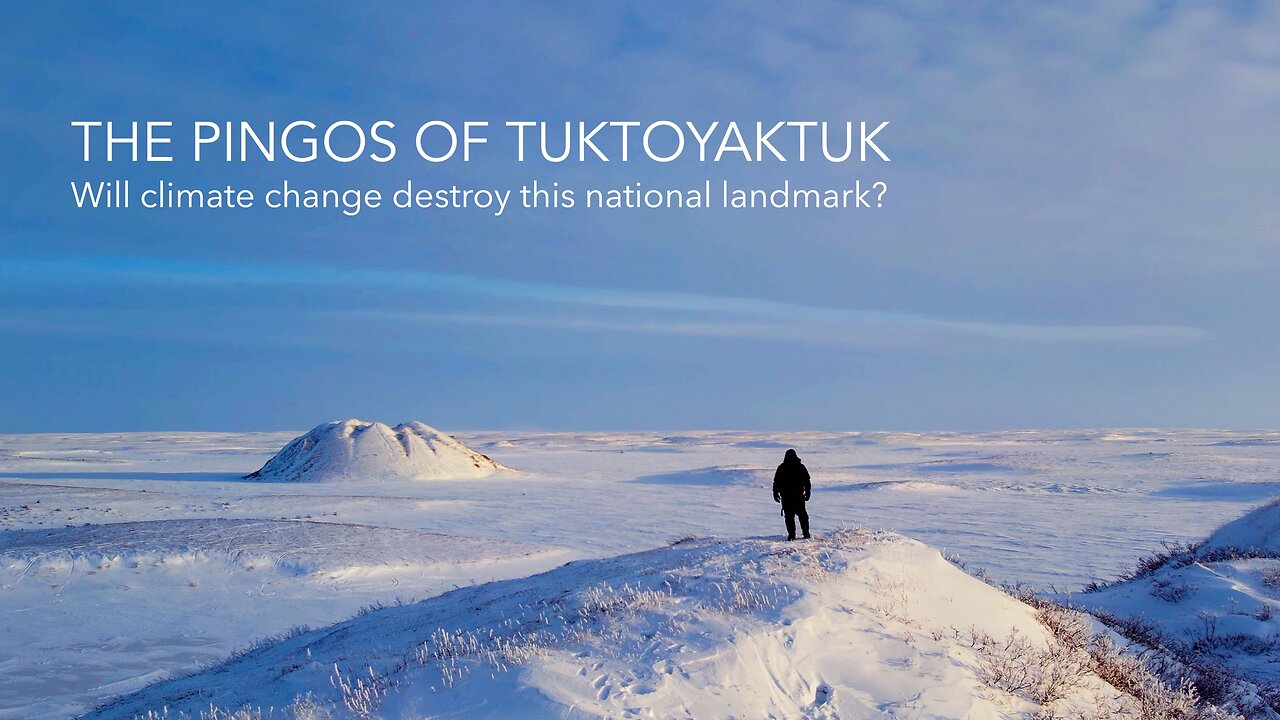Premium Only Content

The Pingos of Tuktoyaktuk | A Landmark of the Western Arctic
For video production services contact inspiredriskproductions@gmail.com https://www.inspiredrisk.com/ https://www.saliqmiut.com/ https://tundranorthtours.com/ https://spectacularnwt.com/
The Pingos of Tuktoyaktuk (Tuktuuyaktuuq) have stood for a thousand years. But is this national Canadian landmark at risk of being lost forever due to the impending destruction of climate change?
Pingos are fascinating geological structures, formed when water trapped in the permafrost freezes and expands, creating these stunning mounds. They can reach heights of over 50 meters, rising majestically above the tundra. But these natural wonders are more than just geological features; they hold deep significance for the local Inuvialuit.
For the Inuvialuit of Tuktoyaktuk, pingos are an integral part of their cultural heritage. They have long served as landmarks, guiding hunters and fishermen through the vast, snowy landscapes. As temperatures rise, the permafrost is melting at an alarming rate, causing many pingos to lose their structural integrity. Over the last few decades, the number of pingos in this region has dramatically decreased, This loss signifies a broader ecological imbalance and the erosion of cultural ties.
When it comes to global warming, Northern communities are the first ones to feel the severe effects, with very little action available for them to slow it down. You can make a difference! Support organizations dedicated to preserving the Arctic and its Indigenous cultures. Share this video to raise awareness, and inspire others to take action for our planet’s future. Together, we can protect these treasures for generations to come.
If you’re willing and able, here are just some actions you can take for Conservation, Climate Change and Animal Welfare;
. Adopt a Plant-Based Diet: Reducing or eliminating animal products lowers demand for factory farming, which is a major driver of deforestation, habitat destruction, animal cruelty and greenhouse gas emissions.
. Support Sustainable Brands and Companies: Choose products and services from companies that prioritize sustainability, ethical sourcing, reducing emissions, minimizing waste and animal welfare in their practices, such as those with certified Fair Trade, organic, or cruelty-free labels.
. Advocate for Wildlife Protection Laws: Support and raise awareness about policies that protect endangered species, regulate hunting, and safeguard critical habitats from destruction through legal means.
. Reduce Energy Consumption: Cut down on electricity and fuel use by investing in energy-efficient appliances, utilizing renewable energy sources, and adopting green practices like switching off lights when not in use and reducing car travel.
. Plant Trees and Support Reforestation Efforts: Trees are vital in the fight against climate change by absorbing carbon dioxide, protecting biodiversity, and supporting wildlife habitats.
. Conserve Water: Freshwater is a limited resource, and conserving water helps maintain critical ecosystems and supports agricultural and wildlife needs.
. Educate and Raise Awareness: Spread knowledge about conservation, animal welfare, and environmental issues. Sharing information on social media or in your community can inspire others to take action.
. Reduce, Reuse, Recycle: Minimize waste by opting for reusable products, recycling materials, and choosing items with minimal packaging to reduce landfill waste and conserve natural resources.
. Volunteer for Conservation Projects: Donate time to wildlife rescue centers, local environmental groups, or global conservation organizations. Direct involvement in conservation efforts can have a meaningful impact on local ecosystems.
. Choose Eco-Friendly Travel: When possible, opt for sustainable travel options like walking, biking, or using public transport.
. Advocate for Climate Policy: Contact local representatives, vote for pro-environmental policies, and join climate advocacy groups pushing for legislative change.
. Compost: Start composting organic waste to reduce landfill contributions and improve soil health.
. Support Sustainable Tourism: Travel responsibly by choosing eco-friendly tours and hotels that prioritize sustainability and wildlife protection.
. Support Wildlife Corridors: Advocate for and support the creation of wildlife corridors that help animals move safely through their habitats.
. Participate in Clean-Up Initiatives: Join local efforts to clean up beaches, rivers, or parks to remove trash that can harm wildlife.
. Practice Sustainable Gardening: If you're growing a garden, use eco-friendly techniques that reduce pesticide use and support biodiversity.
. Adopt, Don’t Shop: Consider adopting rescue animals instead of buying from breeders or pet stores, helping reduce the demand for animal breeding and the number of animals in shelters.
-
 7:43:34
7:43:34
SpartakusLIVE
12 hours agoDuos w/ GloryJean on VERDANSK || #1 Most EATING Streamer
79.8K2 -
 7:25:28
7:25:28
Spartan (Pro Halo esports Player)
14 hours agoSdcrims no comms, then College match
71K1 -
 34:43
34:43
Stephen Gardner
11 hours ago🚨Trump Lawyer makes TWO HUGE ANNOUNCEMENTS | Benny Johnson
106K70 -
 2:17:31
2:17:31
Robert Gouveia
12 hours agoJudge BLOCKS Proof-of-Citizenship! Trump BACK to Supreme Court! Deportee Discovery STAYED!
95.7K36 -
 7:04:37
7:04:37
MyronGainesX
1 day ago $27.90 earnedCollege Debate Reaction, Jordan Peterson Sells Out, Shannon Sharpe Shakedown!
137K46 -
 2:01:49
2:01:49
Joker Effect
9 hours agoWE ARE IN THE WILDWEST! Frontier Legends is crazy!
40.7K -
 3:54:43
3:54:43
FrizzleMcDizzle
10 hours agoELDEN RING and I'm officially a creator on RUMBLE
52.7K1 -
 1:33:35
1:33:35
theoriginalmarkz
12 hours agoEvening News with MarkZ, joined by Jonathan Otto. 04/24/2025
94.3K7 -
 8:02:49
8:02:49
Lilpaul112
12 hours agoSolos On the Island / Repo Time With the Brrrap Pack Gang!
34.8K1 -
 3:56:48
3:56:48
GrimmHollywood
11 hours ago🔴LIVE • GRIMM HOLLYWOOD • REPO with the BRRRAP PACK • THEIR FIRST TIME PLAYING •
32K1